After spending a long time in the kitchen I believe it is time to rest and eat some dhal puri roti. This will be my last post on this auspicious Divali holiday. I hope you enjoyed yours because I certainly enjoyed mine. Everyone who ate from the halwa and parsad enjoyed it and came looking for seconds. I believe I still have a little remaining in the fridge.
I wanted to do another recipe called barfi but I forgot to buy the cream so I guess I would have to do it another time. Dhal puri roti is the fourth type of roti we make in Trinidad and the most labour intensive. That's the main reason why buss up shut , sada roti, and dosti roti are more popular; it is less work than dhal puri.
Time for a Dhal Puri Roti
There is another roti that we make that's really a variation of the dhal puri. Instead of using the dhal as the filling we use potato and it is called aloo puri. I think I will do that one also later on for you all to see. Today we decided to make a few dhal puri to celebrate Divali in our own way. Now you have to remember that during divali no meat dishes are prepared so if you went to a Hindu home today, do not expect meat. Oh! and how could I forget the Sohari leaves, instead of a plate to eat in. In some homes you would be served on special leaf instead of a plate.
So as I was saying, this roti is labour intensive but I had a few tricks up my sleeve to cut down on labour. The labour comes from the grinding of the split peas. Long time we used a hand mill to grind the peas and that took forever, especially if you were making a lot of dhal puri. Since I had no mill today I tried using my magic bullet and to my surprise it worked easy as 1, 2, 3. That was the fastest I ever ground the split peas, so from now on I will be using this method. Here's Dhal Puri roti. Enjoy!
Dhal Puri Roti Recipe
1 cup split peas
1/2 tsp. saffron powder
3 cloves garlic
5 cups flour
1 tbsp. baking powder
1/2 tsp. salt
1/2 tsp. geera
1 tbsp. ghee
1/4 cup oil
water for kneading
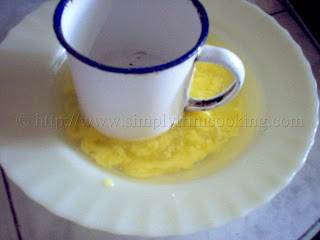
This will be used to grease the tawah and the dhal puri while cooking.
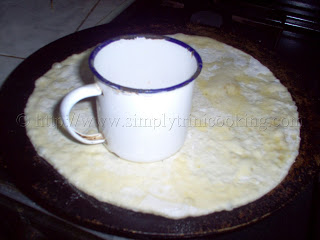
Grease the top, cook on one side, turn over, and cook on the other side.
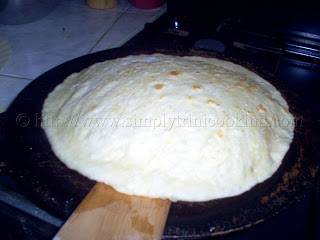
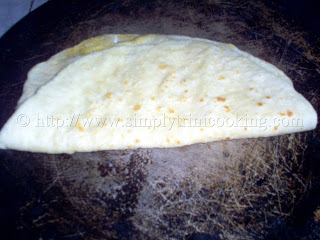
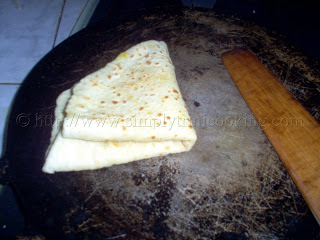
(like in the very first picture)
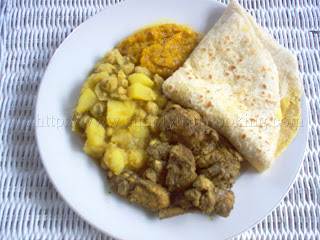
That's it for my Divali posts today I hope you enjoyed the recipes. Until then, bye!
Dhal Puri Roti
Ingredients
Instructions
- Sift the flour with the baking powder and salt. Knead flour to a soft dough. Rub oil over the dough. Make dough into 6 or 8 balls (loyas) according to the size of the tawah. Leave to rest.
- Boil the split peas with saffron, salt and a clove of garlic and drain. Grind the split peas with a small hot pepper and 2 cloves of garlic.
- Add geera, salt to taste. Mix well and set aside. Open the each ball of dough and place in the centre, 2-3 tbsp. of split peas as the filling. Pull the sides over and close up. Turn over and leave to rest.
- Roll out the dough very thinly. Heat tawah on a medium heat. Grease the tawah and place the rolled out roti.
- Grease the top, cook on one side, turn over, and cook on the other side. Be sure to press the edges of the roti when the dhal puri is cooked and swells, fold and place in a bowl to cool.

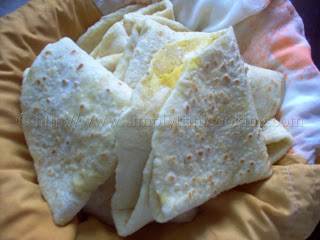
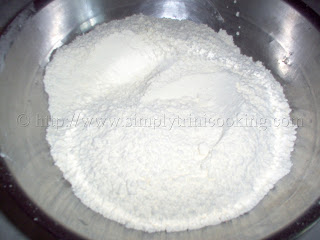
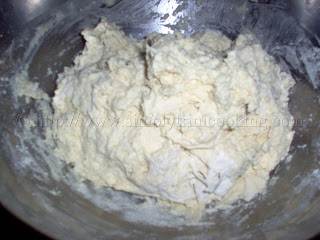
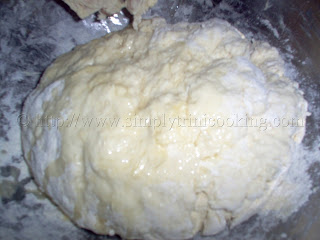
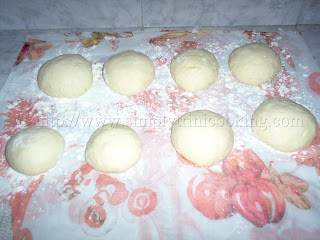
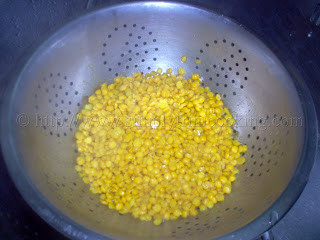
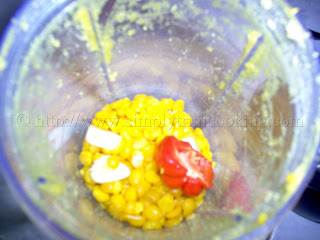
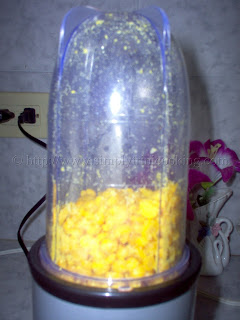
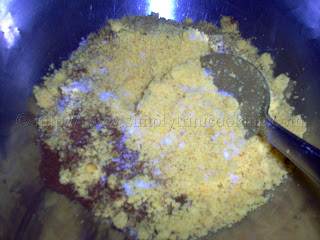
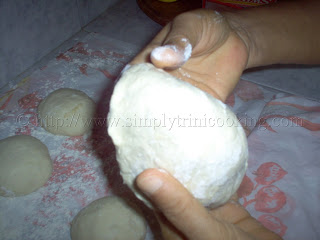
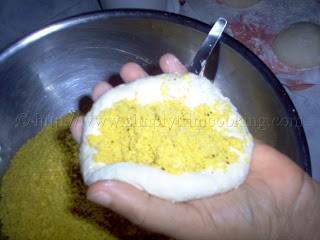
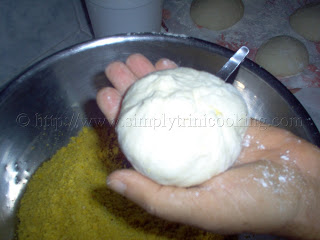
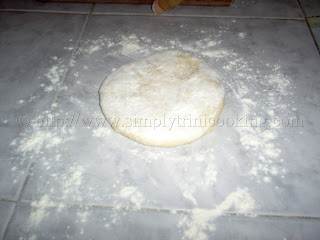
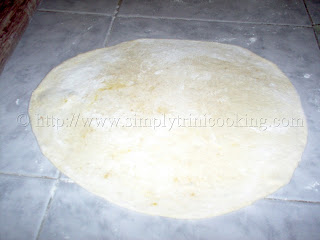
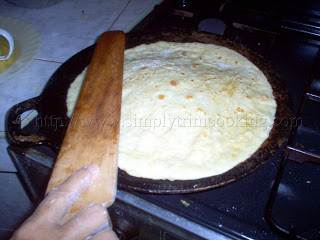
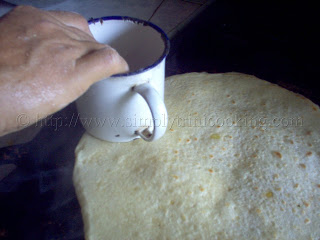
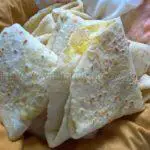
Help! I think there is a step missing. I see step 2 is to oil the soft dough but what am I adding to make it soft? There is no water listed in your ingredients or am I using oil and reserving some for the top? This may seem like a silly question but this is my first time trying dhal puri and I don’t want to mess it up. Thanks!
Yes, you have to knead with water.Add a little at a time until the dough is soft. This type of roti requires some practice so don’t give up and thank you for the observation. 🙂
Excellent instructions and pictures. But whenever i try to make dhalpuri or aloo puri the filling always comes out when i roll out the dough. I there a special way to fold the dough over the filling.
thanks
earlene
Thank you for the comment Earlene. To my knowledge there isn’t any special way to to fold the dough just fold and close and remember to turn it over and leave it to rest for a while before rolling it out.Hope this helps.
Hey i am a Trini living in Hungary,next weekend i will betrying your recipe, for my inlaws ,my wife have a weakness for curry,wish me luck..
If the filling is coming out, it may be that your dough is too dry, it needs a lot of water to make it flexible enough to take the filling, and as Felix says, it does need to rest for a while before you add the filling.
A tip I find useful is to grind a large quantity of dahl and then freeze it in zip-lock bags, this makes it much less hassle to make dahl puree after a long day at work, or if you only want to make a small quantity, and it also saves on the washing-up!
cooked dahl-puree also freeze and reheat quite well.
Good luck!
Thanks for posting this recipe. I was wondering how long you cook the split peas before placing them in the magic bullet.
Gabrielle that’s a tricky question for two reasons: I never really timed how long the peas took to boil and, according to my mom, there are two kinds of split peas that we get here in Trinidad that cook differently. One cooks and melts easily, while the other will boil but stay firm. Rather check the peas regularly while boiling and go more for texture. What you want is a sort of semi cooked state where the peas crushes easily between the fingers but not too soft.
Is this post closed to questions? I have made dhal roti on many occasions but after its all done and i m sitting down eating it i cant get it to flake when i break in half. I know this is trivial but its how my mom made her roti and i miss her and her style of cooking. So any ideas how to insure that after the roti is done when you tear it to eat that the dhal will flake out?
You have to explain to me what you mean exactly. Send me an email and I’ll try to help. 🙂
Hi, I am wondering if anyone has tried refrigerating or freezing the dough balls (filled with dahl) and rolling and cooking them at a later date?
Hi, I believe freezing will place water into the dough and make it more difficult to handle. If you want to have your dhal puri later it might be best to make it and freeze it. You just have to steam the roti when you need it.
I saw something similar in a cookbook and I wanted to make it, but I have a question. Don’t the split peas come out of the dough when you roll it out?
No it doesn’t.
Thanks! One more quick question if you don’t mind. Is this eaten as an accompaniment to another dish or as a snack on its own? I guess I’m just trying to figure out how to serve it if I make it. Thanks again.
It’s eaten as a you would a wrap. Check out the last picture to see what I’m talking about.
My family loves dhal puri, but I haven’t been great at it. My daughter’s bday party is tomorrow, do you think I can order the puri, freeze and reheat on tawah and it doesnt spoil by tomorrow afternoon?
Hi Holly, you can freeze it and heat it in the oven. That’s what I do 🙂
I am having some problems with some of my skins. Some come out a bit harder than normal or not able to handle the curry meat and other fillings without mashing up. What could be causing this? Should I kneed the dough softer by adding more water or baking powder? Also what is the recommended time to first flip the skin after putting it on the tawah and bushing it with the ghee/oil mixture? Also after first flipping how often should I continue to flip the skins? I read somewhere that 3 minutes is good for total time cooking. I am using a 15 inch steel tawah.
Hi Brian,
I don’t think the recipe needs to be altered, it’s just a matter of technique to cook the dhal puri.
There are many factors that could account for your dhal puri coming out hard or too soft much of which could be from how high you have the fire, to how thin you roll out the dough; to actually overcooking the dough.
Here are some pointers:
When you put the dough on the tawa watch to see when the bubbles are about to form, then flip.
You don’t want bubbles forming too much or else it will cause the dhal puri to cook unevenly when you flip it.
Then you cook the other side making sure to spread the ghee.
If all goes well the dhal puri should swell naturally. By then the dhal puri would have been cooked and all you have to do is fold it and place it in a bowl to cool.
As for the time it takes for this to happen I don’t know (too many factors involved) because there are times the tawa gets too hot and you have to lower the flame a bit.
It takes practice but if you look for the signs I’ve explained you’re supposed to make dhal puri well.
Good comment 🙂
Thanks Felix!
Felix, what is the best method of storing dhalpuri? I have covered them with the moist towel, but was wondering should I continue to do that or put it in plastic bag. My auntie in Trini says just cover with towel and reheat, but is there a better method?
Also thanks for the suggestions b4, my dhalpuri taste much better and nice and pliable like a roti shop in Trini. 🙂
Brian it’s nice of you to continue honing your roti making skills. Keep up the good work 🙂
Storing depends on how long you want to store it for. We usually wrap the roti in a towel like your aunt advised, but for longer periods it is best to freeze it then reheat in an oven ….I sound like I’m repeating myself lol
The recipe calls for ghee and oil. It says to put the oil over the dough, but when do you use the ghee?
Sandra
I just want to thank you for posting this lovely recipe. I have been searching all over for a good recipe for this specific roti skin. Thank you again!!! Many many blessings.
quick question i dont live in Trinidad anymore and ghee is hard 2 find so could i use a substitute for the ghee? plz need help urgently
nikki you can use butter 🙂
I don’t have a bullet or a grinder….will a food chopper work?
Do you mean food processor? A food processor could grind the peas fine enough for dhal puri.
I made the dhal puri rotis using your recipe today , it tastes wonderful. Thanks for the recipe, the pictures really helps.
The only problems I had were that the split pea mixture was more pasty than in your picture(may be I boiled it for too long) and it kept falling out of the dough, so I just incorporated the split pea into the dough instead of leaving it in the centre and after that it was easier for me to roll out the dough. I need more practice making them though , so I will be making more dhal puri roti in the future.
Probably you boiled it a bit too long but that’s a complex matter. Different types of split peas are on the market; in Trinidad we have two types that have different cooking times and textures which could be a pain if you know what I mean. With practice you will get it perfect. Thanks for trying the recipe 😀
Felix I see you using “ah namel” cup like me boy is d best thing to use
Nothing like an enamel cup to spread de oil 🙂
hey, like stated, it’s really important to let the dough rest (develops gluten and makes it stretch more easily)….. if you boil it too much you can throw it on a sheet tray and place it in the oven on low heat(250 or so) to let it dry out a bit so that it wouldn’t grind up too pasty……….. food processor is works well too. Also,when you fill the balls be sure to sprinkle a little a.p flour over the dhal before closing up…this helps with rolling out and keeping filling inside ball…….one more thing, when flattening out your ball of dough to place filling inside, be sure to leave the middle thick and the edges thin…this too keeps the roti from bursting…. hope this helps! 🙂
thanks for your recipe…..was looking to compare to what I do… trying to figure out how to make it the softest possible….. some ppl add fat into the dough itself(margarine or shortening)…. experimenting yet.
Not as yet but I do know that some people knead with milk instead of water. Maybe you could try that. 🙂
Hi my friend! I wish to say that this post
is amazing, nice written and include
almost all significant infos. I would like to see more posts like this.
brilliant post. I came a’searching because I wanted to know whether I could use a food processor to grind the peas. perfect! I just couldn’t face borrowing a grinder and making a right mess in the kitchen!
My fiance is Trini…me, a straight up NY city girl. I come from a family of cooks…soul food, latin food, italian food, desert baking and recently I’ve begun oriental. He has been buying me tradition trini cook books. I’m so afraid to mess up. This recipe seems simple enough. We both love roti. Wish me luck!
Hello,
Thanks for the helpful recipe. I’m a bachelor and tried making my own Dhalpuri roti today – Divali, and it came out fairly great.
I make my “loyas” (balls of dough) a bit too large for the size of the tawah, so they rotis were not as thin as they should have been – but they swelled out perfectly.
Your recipe was more or less what I’d seen my mother do over they years.
Thank you Greg for trying the Dhalpuri recipe 🙂